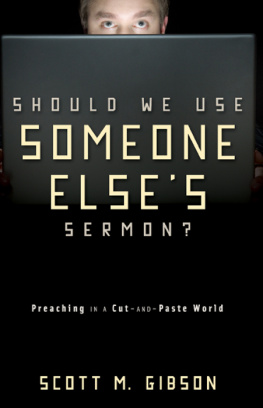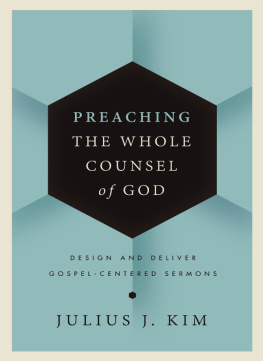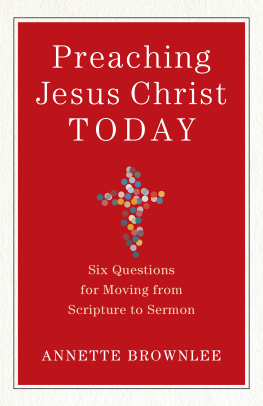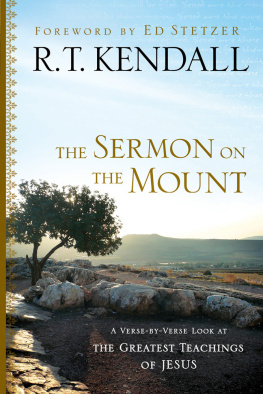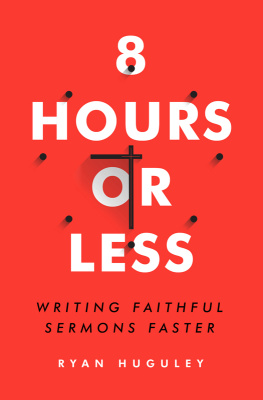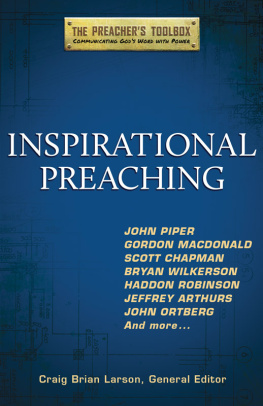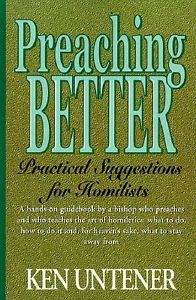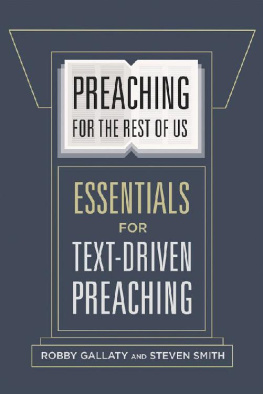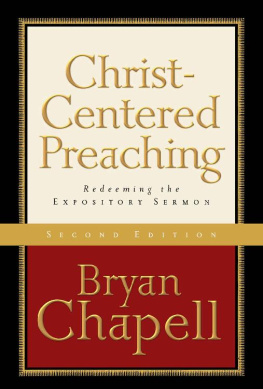How Effective Sermons Advance
Ben Awbrey

How Effective Sermons Advance
Copyright 2011 Ben Awbrey. All rights reserved. Except for brief quotations in critical publications or reviews, no part of this book may be reproduced in any manner without prior written permission from the publisher. Write: Permissions, Wipf and Stock Publishers, 199 W. 8th Ave., Suite 3, Eugene, OR 97401.
Scripture taken from the NEW AMERICAN STANDARD BIBLE, Copyright 1960, 1962, 1963, 1968, 1971, 1972, 1973, 1975, 1977, 1995 by The Lockman Foundation. Used by permission. www.Lockman.org
Chapter 1Sermon Structures Cornerstone: The Sermon Proposition, was extracted from the book How Effective Sermons Begin , Mentor, 2008. Used by permission.
Resource Publications
An Imprint of Wipf and Stock Publishers
199 W. 8th Ave., Suite 3
Eugene, OR 97401
www.wipfandstock.com
isbn 13: 978-1-60899-970-5
eisbn 13: 978-1-4982-7294-0
Manufactured in the U.S.A.
Foreword
I n Arabian Sands, Wilfred Thesiger spreads a verbal canvass in which he paints a vivid picture of what has become known as the Empty Quarter in the Arabian Peninsula. This is the desert of all deserts where one may suddenly find himself sinking into quicksand; but if he is searching for the liquid of life, he either knows exactly where he is going and has provisions to get there, or else helike many others who have ventured into this desertwill never venture out. The scarcity of water in the Empty Quarter reminds me of the infrequency with which one finds genuine biblical preaching in the churches of our era. The sparseness of anything that could be called meaningful life in the Empty Quarter has its double in the churches of the land as a result of the infrequent appearance of those spiritual oases where the Bible is actually taught.
In this volume, Ben Awbrey, Associate Professor of Preaching at Midwestern Baptist Theological Seminary in Kansas City, Missouri, has provided the finest conceivable instruction on How Effective Sermons Advance . This second volume follows a highly successful and helpful volume one, How Effective Sermons Begin, published in 2008. For a good many preachers, How Effective Sermons Advance will be a book, to change the metaphor above, that will resemble throwing ice water into the face of a nearly frozen man. Many contemporary preachers will allege that the message of the book, and the stratagem enjoined upon the preacher is dated and totally ineffective in the postmodern milieu. But for many tortured church members who are forced to wander some Saharan wilderness of contemporary, shallow preaching, this volume will be ice water to the parched throat of the thirsty believer who wishes spiritual refreshment; and it will be life-saving water for those who are lost and need to know the Savior. Awbreys position, which he unpacks for his readers in the following pages, is based upon the contention that the information provided on the pages of Holy Scripture is not optional. Awbrey believes that the text of Holy Scripture was given from God as special revelation and that the Word of God is sealed forever in heaven (Psalm 119:89). Consequently, he believes that the best preaching in any day is still what has most often been referred to as exposition. While I certainly have no quibble with that term, I prefer to note simply that Awbrey promotes biblical preaching, which is defined as the careful teaching of all aspects of the special revelation with application of didactic narrative, as well as hortatory passages for the lives and eternities of those who hear the preacher. In order to accomplish this task, Awbreys determined conviction is that a sermon needs to have structure.
The argument presented in this compelling volume does not attempt to superimpose on the biblical text some pedantic external mode but seeks to discover the structures that are provided in the sacred text itself. Awbrey does this while carefully avoiding the error of removing the personality of the preacher since he believes in the incarnational delivery of the message of God in every generation. There is no attempt on Awbreys part to clone preachers but rather the determination to insist that sermon structure is in fact a necessity and not a luxury, inspiring the title of the third chapter. Reasons for this position are provided in both the fields of communication in general and specifically in theology.
Subsequent chapters demonstrate that commitment to structure, far from being a liability, is a desirable asset and that the structure of the sermon actually serves as the statement of theological principle. Furthermore, Awbrey demonstrates visibly that the congruity of the text itself is at stake. Toward the end of the volume he also discusses stylistic components that should be present in an appropriately structured sermon and proceeds in a most perceptive way by anticipating the results that arise from well-structured discourse for preacher, congregation, and the contemporary church as a whole.
Throughout the entire volume, Awbrey has first provided the principles that ought to be part of a structured approach to preaching; and then, not content to leave his readers with theory alone, he has provided superb examples of the craft he advocates. These examples, which act as illustrations to cast light on the theories advanced in this volume are among the most helpful additions to the book and are reasonably rare in books on homiletics. In the process of the preparation of the volume, Awbrey demonstrates a rather remarkable grasp of numerous fields of investigation from theology to hermeneutics to the latest in homiletical theories and the advocates of those theories. But in the end, Awbrey is his own man, advocating a method of proclaiming the unsearchable riches of Christ, which is uniquely biblical.
One of the most amazing accomplishments of this volume is a feature that will combine both insight and inspiration. Most preachers with whom I have visited during my fifty years in ministry, when asked about preaching from the book of Proverbs, muster a rye smile and mutter something under their breaths about the fact that most of it is not really preachable. Proverbs seems to be a fine book of religious aphorisms, but what in the earth could it possibly have to do with preaching? At the first of every chapter Awbrey uncovers in Proverbs a veritable gold mine for the preacher. He has marshaled from its wisdom ten to fifteen verses, that have a direct impact upon the preaching of the Word. By the time I finished reading the manuscript, I wondered why homiletitians have not insisted that their students virtually memorize the book of Proverbs as a precursor to the faithful preaching of the Word of God. One cannot help but conclude that a thorough grasp of the message contained in the proverbs of Solomon and the other contributors to that book would have made possible the avoidance of a thousand common mistakes in the pulpit.
In the midst of a generation that seems determined to abandon genuine biblical preaching, Ben Awbreys How Effective Sermons Advance becomes a critically important volume. The concepts that he is advocating are those to which I have been committed for most of my ministry. Nevertheless, I found the book both stimulating and challenging, and I express my gratitude to this professor of homiletics at Midwestern Seminary for his labor of love in producing this volume. In short, if you want to learn how to do genuine biblical preaching and you are unselfish enough to desire that the congregations who hear you preach grow in the nurture and the admonition of the Lord, this is one book that cannot be optional. With gratitude to God and to its author, I warmly commend it to you.


